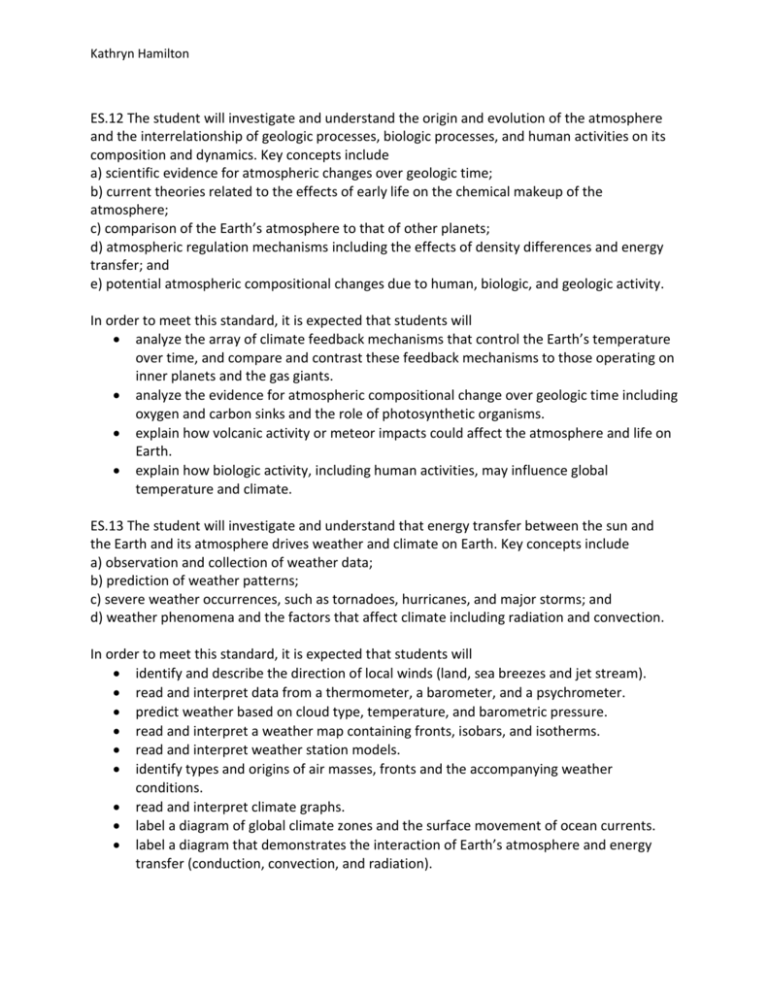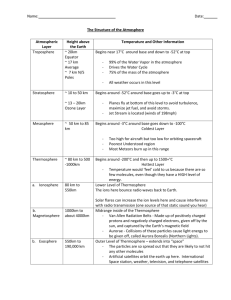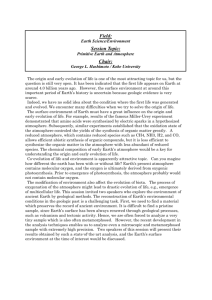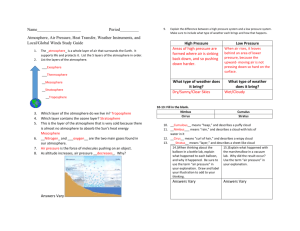Meteorology Test - Kathryn Hamilton
advertisement

Kathryn Hamilton ES.12 The student will investigate and understand the origin and evolution of the atmosphere and the interrelationship of geologic processes, biologic processes, and human activities on its composition and dynamics. Key concepts include a) scientific evidence for atmospheric changes over geologic time; b) current theories related to the effects of early life on the chemical makeup of the atmosphere; c) comparison of the Earth’s atmosphere to that of other planets; d) atmospheric regulation mechanisms including the effects of density differences and energy transfer; and e) potential atmospheric compositional changes due to human, biologic, and geologic activity. In order to meet this standard, it is expected that students will analyze the array of climate feedback mechanisms that control the Earth’s temperature over time, and compare and contrast these feedback mechanisms to those operating on inner planets and the gas giants. analyze the evidence for atmospheric compositional change over geologic time including oxygen and carbon sinks and the role of photosynthetic organisms. explain how volcanic activity or meteor impacts could affect the atmosphere and life on Earth. explain how biologic activity, including human activities, may influence global temperature and climate. ES.13 The student will investigate and understand that energy transfer between the sun and the Earth and its atmosphere drives weather and climate on Earth. Key concepts include a) observation and collection of weather data; b) prediction of weather patterns; c) severe weather occurrences, such as tornadoes, hurricanes, and major storms; and d) weather phenomena and the factors that affect climate including radiation and convection. In order to meet this standard, it is expected that students will identify and describe the direction of local winds (land, sea breezes and jet stream). read and interpret data from a thermometer, a barometer, and a psychrometer. predict weather based on cloud type, temperature, and barometric pressure. read and interpret a weather map containing fronts, isobars, and isotherms. read and interpret weather station models. identify types and origins of air masses, fronts and the accompanying weather conditions. read and interpret climate graphs. label a diagram of global climate zones and the surface movement of ocean currents. label a diagram that demonstrates the interaction of Earth’s atmosphere and energy transfer (conduction, convection, and radiation). Kathryn Hamilton analyze the impact of satellite technology on weather prediction and the tracking of severe storms, including hurricanes, and evaluate the cost and benefits of this technology in terms of lives and property saved. Predict the impact on storm preparedness if there were no weather satellites. Content Meteorology Atmosphere composition KN CO Understand Explain Cognitive Level AP AN Compare and contrast SY EV 9 Layers Lab Energy transfer of atmosphere Understand Analyze Human impact on atmosphere Weather data and Patterns Explain Understand 13, 19 Understand Collect Observe Describe Interpret 4, 6, 10, 16 1, 2, 8 Read Identify 3, 5, 12 18 Differential heating Lab Predict 5, 17 Weather Journal Severe weather Read Impact on climate Label Understand Interpret 11, 14, 20 Understand 7 Analyze 15 Climate Lab Evaluate Predict Kathryn Hamilton 1. Which area of the Earth receives almost-vertical rays of the sun all through the year? (2pts) a. High latitudes b. Middle latitudes c. Latitudes near the equator d. All of the above 2. If you are standing on a beach in the afternoon, where will the wind be coming from? (2pts) a. The east b. The land c. The ocean d. The west 3. What type of front does this image indicate? (2pts) a. b. c. d. Warm front Cold front Occluded front Stationary front 4. What type of weather would typically form from the above front? (2pts) Kathryn Hamilton 5. You are looking out the window after school on Friday. You are planning to go out with friends tomorrow. You notice a dark cloud on the horizon (like the one pictured to the left). In a paragraph, predict the weather for the next day and a reason why you predict those conditions. Include in the information: What type of cloud are you seeing? What do you predict the weather to be tonight? What will the weather be like tomorrow? (10pts) Label the six air masses. (3 pts each) 6. a. b. c. d. e. f. 7. Define climate change and global warming. Explain the difference between the two. (6pts) Kathryn Hamilton 8. What causes currents in the atmosphere? (2pts) a. Ocean waves and currents b. Pressure from the ozone layer c. Solar heating of the upper atmosphere d. Warm air rising and cold air sinking 9. Draw the atmosphere and label the 4 layers as well as the separators. Make sure to include the exosphere, ionosphere, mesosphere, thermosphere, troposphere, and stratosphere. (10 pts) Kathryn Hamilton 10. In which of the following graphs would the precipitation at ground level most likely be rain? A B C D (2pts) Kathryn Hamilton 11. The lines on the map to the left show the origin and path of a few hurricanes. Based on this information, most hurricanes occur where the (2pts) A. oceans are warmest B. land masses are largest C. atmosphere is driest D. areas of greatest population exist 12. Match the instrument with what it measures: (1pt each) a. Psychrometer g. Amount of precipitation b. Weather vane h. Height of clouds c. Anemometer i. Wind direction d. Rain gauge j. Temperature e. Barometer k. Relative Humidity f. Nephoscope l. Atmospheric pressure m. Wind speed 13. What is an example of a greenhouse gas, and what effect does it have on the atmosphere? How is it introduced to the atmosphere? (6pts) 14. What causes a hurricane to weaken over land? (4pts) 15. How were the fossil leaves in the climate lab used to determine climate change? (6pts) Kathryn Hamilton 16. Label the seven symbols on this map. (1pt each) 17. Based on the above map, what would you predict the weather to be like in Virginia for the next few hours? (2pts) 18. On clear nights in late summer and early fall in the Shenandoah Valley, why does ground fog form in low areas near the Shenandoah River? (2pts) a. Cool, descending air meets moist air in the low areas near the river b. Cool, moist air ascends from the river to the hilltops c. Warm winds bring moisture from the hills down into the valley d. There is more air pollution in the evenings 19. What is NOT a form of air pollution? (2pts) a. CO b. CO₂ c. O₃ d. NO₂ 20. Why don’t blizzards, like the one in Connecticut that we watched the video of, not occur here on the coastal plain of Virginia? (6pts) Kathryn Hamilton Key 1. C (core test) 2. B 3. C 4. Stormy weather 5. Cumulonimbus cloud, rainy weather tonight and cold tomorrow Item 0 Pts 1 Pt 2 Pts Cloud Wrong answer Cloud of vertical cumulonimbus Identification given development Weather Tonight Wrong answer Student gives Student gives given description of description of weather without cloudy, rainy mentioning rain or weather without a cloudy. reason behind it. Weather tomorrow 6. Wrong answer given Student gives partial, but not complete description of the weather. (cold but not windy) Student gives description of the weather without a reason behind it. 4 Pts Rain because the cloud will move over the area and once the dew point is reached, it will become too saturated to withstand any additional moisture. cold and windy because the cold front will have moved in creating the lower pressure and the wind. (going from left to right top to bottom) a. mP b. cP c. mP d. mT e. cT f. mT 7. "Global warming" describes an average temperature increase of the Earth over time. Climate change" describes how weather patterns will be affected around the globe 8. D (core test) 9. 2 pts each for Troposphere, Stratosphere, Mesosphere, and Thermosphere in proper place, One point each for Ionosphere and Exosphere labeled in the right place in the thermosphere. Kathryn Hamilton 10. 11. 12. 13. 14. 15. 16. 17. 18. 19. 20. A (core test) A (core test) A=k, b=i, c=m, d=g, e=l, f=h CO₂ increases temperature, introduced through burning of fossil fuels (two points for gas, cause, and response.) When the hurricane is over land the moisture is reduced which weakens the winds. Fossil leaves were compared based on smoothness of the edges. The percentage of smooth edged leaves found were used to calculate the temperature of the time frame. The fossil leaves were found in two sedimentary layers from two epochs in the same area of Wyoming. The difference in temperature from the two sites showed the change in climate. (going from left to right) a. Low pressure b. Occluded front c. Stationary front d. High pressure e. Low pressure f. (top to bottom of line) warm front, stationary front, cold front Temperatures will decrease and rain will move into the area A (core test) B The temperature in the area keeps the snow from forming. We could get the storm system but it would probably be a flood rather than a blizzard.







